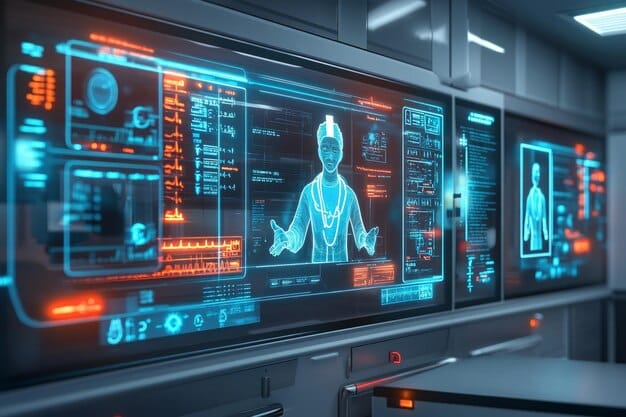AI-Powered Diagnostics: Reshaping US Healthcare by 2025

The integration of artificial intelligence into diagnostics is set to revolutionize US healthcare by 2025, promising enhanced accuracy, efficiency, and accessibility, moving beyond conventional methods to offer personalized and preventative care solutions across diverse medical fields.
The landscape of healthcare in the US is on the brink of a profound transformation, driven by the accelerating integration of artificial intelligence (AI). A key area set to be significantly impacted is diagnostics, where AI promises to introduce unprecedented levels of precision, speed, and analytical depth. This evolution raises a critical question: How will AI-powered diagnostics reshape US healthcare by 2025? By understanding the nuances of this technological shift, we can better anticipate the changes, challenges, and immense opportunities it presents for patients, providers, and the entire healthcare ecosystem.
The Dawn of AI in Diagnostic Medicine
The integration of Artificial Intelligence into diagnostic medicine marks a new era in US healthcare. This transformative shift goes beyond mere automation, delving into sophisticated pattern recognition and predictive analytics that promise to enhance diagnostic accuracy and efficiency. By processing vast amounts of patient data at speeds humanly impossible, AI is poised to provide clinicians with invaluable insights, aiding in earlier disease detection and more personalized treatment plans.
Artificial intelligence in diagnostics encompasses a broad spectrum of technologies, from machine learning algorithms that identify subtle anomalies in medical images to natural language processing systems that extract crucial information from electronic health records. These tools are designed not to replace human experts but to augment their capabilities, allowing them to focus on complex cases and direct patient care. The potential for AI to streamline diagnostic workflows and reduce diagnostic errors is immense, hinting at a future where healthcare is more precise and patient-centric.
Early Detection and Precision Diagnostics
One of the most compelling advantages of AI-powered diagnostics is its capacity for earlier disease detection. AI algorithms can detect minute changes in medical imaging, pathology slides, or even genetic data that might be imperceptible to the human eye, even that of a seasoned specialist. This capability is particularly critical for conditions where early intervention significantly impacts patient outcomes, such as certain cancers and neurological disorders.
-
Enhanced Image Analysis: AI systems can quickly analyze complex imaging data like MRIs, CT scans, and X-rays, identifying potential issues with greater accuracy and speed than traditional methods.
-
Pathology and Genomics: AI aids pathologists in reviewing slides, flagging suspicious cells, and can analyze genomic data to predict disease risk and guide targeted therapies.
-
Predictive Analytics: Leveraging patient history and real-time data, AI can predict the onset of certain conditions, enabling proactive rather than reactive care.
These advancements lead to not just earlier diagnoses but also more precise ones. Precision diagnostics, powered by AI, means understanding the unique biological makeup of each patient’s disease, paving the way for truly personalized medicine that targets the individual effectively. This precision will become a cornerstone of US healthcare by 2025, moving away from a one-size-fits-all approach.
Streamlining Clinical Workflows and Efficiency Gains
The operational benefits of AI in diagnostics extend far beyond improved accuracy. Its ability to automate routine tasks, prioritize urgent cases, and synthesize information from disparate sources will significantly streamline clinical workflows, leading to substantial efficiency gains throughout the US healthcare system. This means less time spent on administrative tasks and more time dedicated to patient interaction and critical decision-making.
The diagnostic pipeline, traditionally laden with manual processes and potential bottlenecks, stands to be optimized by AI. From initial patient screening to final diagnostic reports, AI tools can accelerate every stage, reducing wait times for patients and alleviating the burden on healthcare professionals. This operational overhaul is crucial for a healthcare system grappling with rising demand and limited resources.
Automating Repetitive Tasks
AI excels at repetitive, data-intensive tasks, freeing up human professionals for more complex and empathetic roles. In diagnostics, this includes initial screening of images, data entry, and even drafting preliminary reports.
-
Radiology Prioritization: AI can quickly scan incoming radiology images and flag those showing critical findings, ensuring urgent cases are reviewed by radiologists first.
-
Lab Test Interpretation: AI can analyze vast quantities of lab results, identifying patterns and flagging abnormalities that warrant further investigation, reducing manual review time.
-
Documentation Assistance: AI-powered natural language processing (NLP) can assist with documentation by transcribing doctor-patient conversations and extracting relevant information for electronic health records (EHRs).
This automation not only reduces the workload but also minimizes the chances of human error in high-volume, monotonous tasks. It allows highly trained medical professionals to apply their expertise where it is most needed, enhancing overall healthcare quality and reducing burnout. The impact on physician well-being and patient access to care will be profound by 2025.
Addressing Healthcare Disparities and Access
One of the most promising aspects of AI-powered diagnostics is its potential to mitigate existing healthcare disparities and improve access to quality care across the United States. By reducing the reliance on highly specialized human expertise in every location, AI can democratize diagnostic capabilities, making advanced medical assessments available to underserved populations. This is particularly vital in rural areas or regions with a shortage of specialists.
The centralized computing power and analytical capabilities of AI can be deployed remotely, enabling tele-diagnostics and virtual consultations that were previously limited. This expansion of access could fundamentally change how healthcare is delivered, ensuring that geography or socioeconomic status does not dictate the quality of diagnostic services a patient receives. It’s a step towards more equitable healthcare by 2025.

Democratizing Expert-Level Diagnostics
AI can bottle the expertise of top specialists and distribute it widely. A machine learning model trained on diagnoses from leading experts can bring that “expertise” to a small clinic in a remote town.
-
Rural Healthcare Support: AI tools can support general practitioners in rural settings with complex diagnostic challenges by providing expert-level analysis of patient data and medical imagery.
-
Telemedicine Enhancement: Integrating AI into telemedicine platforms allows for more comprehensive remote diagnostics, making virtual care a more robust option for various conditions.
-
Cost Reduction: By optimizing diagnostic pathways and reducing the need for extensive in-person specialist consultations, AI can contribute to lowering healthcare costs, making diagnostics more affordable.
This capacity to democratize high-quality diagnostic services is a game-changer. It addresses the critical issue of specialist shortages and geographical barriers, offering a pathway to better health outcomes for millions of Americans who currently lack adequate access to advanced medical evaluations. The societal impact of this shift cannot be overstated.
Challenges and Ethical Considerations
While the potential of AI-powered diagnostics is vast, its widespread adoption in US healthcare by 2025 is not without significant challenges and ethical considerations. These issues range from data privacy and algorithmic bias to regulatory hurdles and the integration of new technologies into existing infrastructure. Addressing these concerns is crucial for ensuring that AI contributes positively and equitably to healthcare.
Navigating the complexities of data governance, ensuring fair and unbiased algorithms, and securing patient trust will be paramount. Without robust frameworks and thoughtful implementation, the benefits of AI could be undermined by unintended consequences or a lack of public confidence. The healthcare industry, policymakers, and ethicists must collaborate to build a responsible path forward.
Ensuring Data Privacy and Security
The foundation of AI in healthcare is extensive patient data, making data privacy and security a top concern. Protecting sensitive medical information from breaches and misuse is critical.
-
Robust Cybersecurity: Implementing state-of-the-art encryption and cybersecurity protocols to safeguard patient data used by AI systems.
-
Regulatory Compliance: Adhering strictly to regulations like HIPAA, and developing new ethical guidelines to govern the use of AI in diagnostics.
-
Patient Consent: Ensuring clear and informed consent processes for patients whose data will be used to train and operate AI diagnostic tools.
Furthermore, the potential for algorithmic bias poses a significant ethical dilemma. If AI models are trained on unrepresentative datasets, they may perpetuate or even amplify existing health disparities, leading to inaccurate diagnoses for certain demographic groups. Developing diverse and inclusive datasets and rigorous testing for bias will be essential.
Regulatory Landscape and Integration Hurdles
The rapid pace of AI innovation often outstrips the development of regulatory frameworks. For AI-powered diagnostics, clear guidelines from bodies like the FDA are needed to ensure safety, efficacy, and accountability. This includes defining pathways for approval, monitoring performance, and addressing liability issues.
Integrating these advanced AI systems into the complex and often antiquated IT infrastructure of existing US healthcare facilities presents another significant hurdle. Interoperability between various systems, data standardization, and the training of healthcare staff will require substantial investment and strategic planning. The success of AI adoption hinges on overcoming these technical and operational barriers.
FDA Approvals and Guidelines
The Food and Drug Administration (FDA) plays a pivotal role in regulating medical devices, including AI-powered diagnostic tools. Establishing clear and efficient pathways for approval is crucial for bringing these innovations to market.
-
Validation Studies: AI diagnostic tools need rigorous clinical validation to prove their accuracy and reliability in real-world settings before widespread adoption.
-
Post-Market Surveillance: Continuous monitoring of AI performance after deployment is essential to identify any unforeseen issues or biases that may emerge over time.
-
Transparency Requirements: Developing standards for transparency and explainability in AI algorithms, so clinicians can understand how a diagnosis was reached.
These regulatory challenges are compounded by the dynamic nature of AI, which often involves continuous learning and updates. Regulators must develop agile processes that can adapt to evolving technology without compromising patient safety.
Impact on Medical Professionals and Workforce
The integration of AI-powered diagnostics will undoubtedly reshape the roles and responsibilities of medical professionals, particularly radiologists, pathologists, and general practitioners. Rather than rendering human expertise obsolete, AI will necessitate a shift in skills and focus, empowering clinicians with advanced tools while redefining what it means to practice medicine in the digital age. This change will require significant investment in training and education.
The fear of job displacement is a common concern with any technological shift. However, in healthcare, AI is more likely to augment human capabilities, automate laborious tasks, and create new roles focused on AI oversight, data interpretation, and patient-centered care. Preparing the workforce for these new demands will be critical for a smooth transition by 2025.

Augmenting Clinical Decision-Making
AI will serve as a powerful assistant, providing clinicians with comprehensive data analysis and diagnostic support, leading to more informed decisions.
-
Decision Support Systems: AI can offer real-time diagnostic suggestions, flag potential errors, and provide evidence-based recommendations, supporting clinicians in complex cases.
-
Time Savings: By automating preliminary analyses, AI frees up doctors to spend more time on direct patient care, communication, and empathy.
-
Training and Education: Medical curricula will need to adapt to include AI literacy, data science skills, and an understanding of how to effectively integrate AI tools into practice.
This evolution will transform the diagnostic workflow from a largely manual and human-intensive process to a highly collaborative one, where human intuition and AI’s analytical prowess combine for superior patient outcomes. It will ultimately elevate the standard of care and allow medical professionals to focus on the humanistic aspects of medicine.
The Future Landscape: Predictions for 2025 and Beyond
By 2025, AI-powered diagnostics will be an indispensable part of the US healthcare system, moving beyond experimental phases to routine clinical application. We can expect to see widespread adoption of AI in imaging analysis, pathology, and predictive analytics, significantly impacting clinical practice and patient care. The initial integration will focus on areas where AI demonstrates clear advantages in accuracy and efficiency, such as oncology and cardiology.
Beyond 2025, the trajectory indicates an even deeper embedding of AI into personalized medicine, preventative care, and public health initiatives. The continuous learning capabilities of AI will allow diagnostic models to improve over time, becoming increasingly sophisticated and nuanced. This will foster a healthcare system that is not only reactive but proactively identifies and mitigates health risks before they fully manifest.
Personalized and Preventative Care
The true promise of AI in diagnostics lies in its ability to drive personalized and preventative care. By analyzing an individual’s unique genetic makeup, lifestyle data, and medical history, AI can predict future health risks and recommend tailored interventions.
-
Risk Stratification: AI tools will enable more precise classification of patients based on their individual risk profiles for various diseases, allowing for targeted preventative strategies.
-
Personalized Treatment Plans: Diagnostic AI will inform treatment decisions, recommending therapies that are most likely to be effective for a specific patient, minimizing trial-and-error approaches.
-
Continuous Health Monitoring: Wearable devices combined with AI diagnostics will allow for continuous monitoring of health metrics, providing early warnings for deviations and personalized health insights.
This shift toward highly personalized and predictive healthcare will redefine patient engagement and medical intervention, fostering a system that is more responsive, efficient, and ultimately, more effective in maintaining public health. The journey to a truly AI-integrated healthcare system is exciting and holds immense promise for the future.
| Key Aspect | Brief Description |
|---|---|
| 🚀 Enhanced Accuracy | AI detects subtle anomalies in medical imaging and data, improving diagnostic precision. |
| ⏱️ Operational Efficiency | Automating repetitive tasks, AI streamlines workflows and reduces diagnostic turnaround times. |
| 🌍 Increased Accessibility | AI supports remote diagnostics, addressing specialist shortages and healthcare disparities. |
| 🛡️ Ethical Challenges | Concerns regarding data privacy, algorithmic bias, and regulatory hurdles require careful navigation. |
Frequently Asked Questions About AI in US Healthcare
No, AI is not expected to replace doctors by 2025. Instead, it will augment their capabilities, acting as a powerful tool to enhance diagnostic accuracy and efficiency. Physicians will likely transition to roles focused on overseeing AI systems, interpreting complex analyses, and maintaining the crucial human element of patient care and empathy.
AI-powered diagnostics will improve patient outcomes through earlier and more precise disease detection. By identifying subtle indicators missed by traditional methods, AI can facilitate timely interventions, leading to more effective treatments and better prognoses, especially for diseases where early diagnosis is critical, such as various forms of cancer.
Key ethical concerns include data privacy and security, ensuring that sensitive patient information is protected. Algorithmic bias is another major concern, where poorly trained AI models could perpetuate or worsen existing health disparities. Additionally, the transparency and explainability of AI’s diagnostic processes are crucial for building trust among clinicians and patients.
AI diagnostics are anticipated to have a mixed impact on healthcare costs. While initial implementation may be costly due to infrastructure and training investments, long-term benefits include reduced diagnostic errors, improved efficiency, and earlier disease detection. These factors can potentially lower overall treatment expenses and improve resource allocation, leading to cost savings over time.
Radiology and pathology are expected to experience the most significant changes, given their heavy reliance on image and data analysis, areas where AI excels. Oncology, cardiology, and ophthalmology will also see substantial advancements, leveraging AI for early detection, personalized treatment planning, and monitoring chronic conditions with enhanced precision and efficiency.
Conclusion
The integration of AI-powered diagnostics is not merely an incremental improvement but a fundamental reshaping of US healthcare. By 2025, we anticipate a healthcare system characterized by unparalleled diagnostic accuracy, enhanced operational efficiencies, and significantly improved access to expert-level care across diverse communities. While challenges related to data security, algorithmic bias, and regulatory frameworks persist, the proactive efforts to address these issues will pave the way for a future where AI acts as a crucial partner in delivering personalized, preventative, and more equitable healthcare. The journey ahead is complex, but the promise of a healthier future, built on the foundation of intelligent diagnostic technologies, is undeniably compelling.





